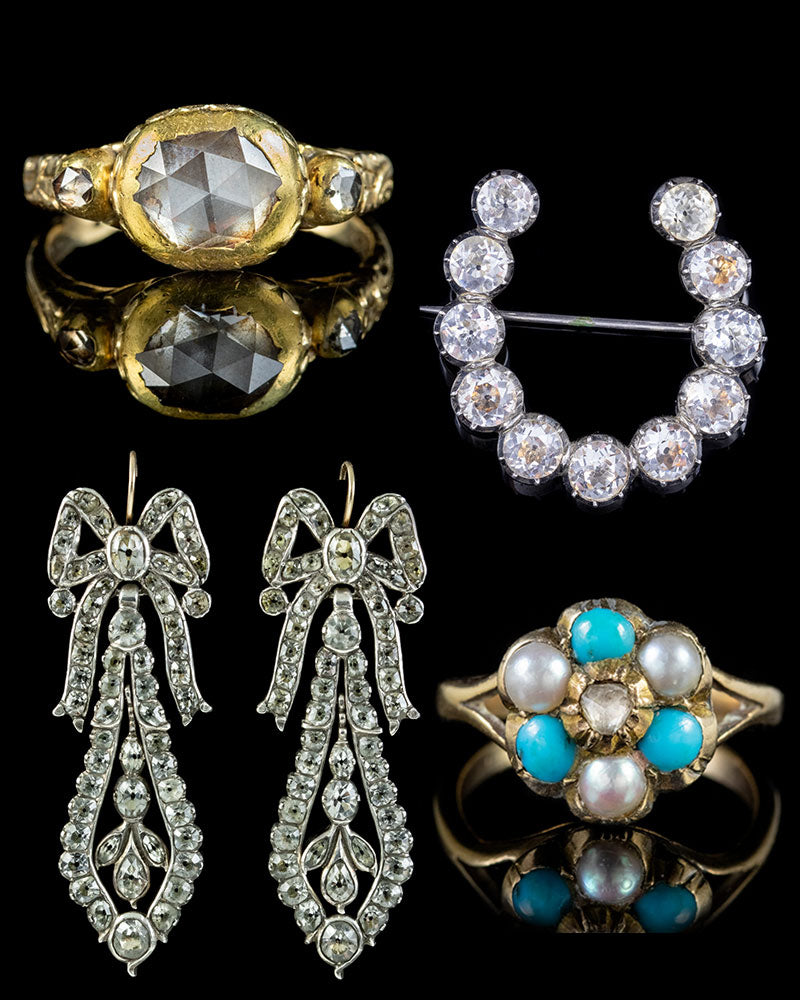Assessing the Value of Antique Jewellery
With decades of experience in the trade the staff at Laurelle Antique Jewellery have a great deal of knowledge in assessing the worth of antique jewellery. To help our customers we’ve put together a quick guide to give you some pointers on how you can tell if your piece is genuinely what the seller tells you it is.

Is it True to the Period?
When you are looking for a piece of antique jewellery you’ll likely have an era whose designs and style suit you best, so it’s worth doing a little reading about the traits that jewellery from that period has.
There are a number of articles on our blog and advice centre which can help you to identify whether a particular item matches the conventions of the age, but the short summary below should give you a sense of some of the major things to look out for.
Georgian Jewellery predates lower carat, stronger metals like 9ct gold. This means that stones will have substantial galleries with crimped collet settings that compensate for the softness of the metal. Stones will also likely be foil backed, meaning that a thin layer of metal is laid across the rear of the stone to reflect light back through it and improve the lustre.

Victorian Jewellery tends to be more sombre in tone than other eras due to the people’s enduring sympathy for the tragic death of Queen Victoria’s consort Prince Albert. Deeper coloured stones such as garnet, along with the deep black jet or onyx, were common. The Victorian period produced a great many memento mori pieces, but also a wide variety of Etruscan-inspired pieces based on ancient antiquity.

Edwardian Jewellery abandoned the sombre nature of Victorian crafts and replaced it with a decadent aesthetic. Edwardian pieces made use of newer, stronger gold alloys which allowed jewellers to create open backed, much more slender galleries which allowed light to flow through the stones unimpeded. This was also the first era where platinum came to be used in jewellery.

Art Deco Jewellery is formed into distinctive geometric shapes with repeating, mathematically precise motifs. White gold and platinum is used more regularly, with large emerald cut stones such as aquamarine taking centre stage. Although Art Deco jewellery can contain arrays of stones many pieces are built around a single central stone which can be many times larger than any other stone in the piece.

Of course, the unscrupulous people who create imitations to pass off as antiques are also aware of these facts, and it can be difficult to tell a finely made fake from a true original. That’s why it’s important to…
How Trustworthy is the Jeweller?
There is something to be said for instinct when buying a valuable item. Meeting with an antique dealer can give you a good sense of their character, and you spot some red flags without being able to specifically pinpoint them. It’s worth going with your gut in these situations, but there are certain things you can look out for which can give you a better idea before you make a decision.
How long have they been in business? Although newer jewellers may be just as skilled and trustworthy as more established companies the amount of time that a jeweller has been in business can tell you a lot. A jeweller who sells fake or poor quality jewellery, or who treats their customers badly, will not stay in business for long.

Are they honest about the condition of their pieces? Many antiques will have picked up wear and tear over the years, and sometimes repairing them can impact the value or look of the piece. If an item is damaged the jeweller should be honest about this fact, and open to assisting you in having it repaired. Many antique jewellers also deal in a small number of modern reproductions to cater for less wealthy individuals, but these should always be marked as such. For instance, if a piece is marked as “Victorian Style” it is a reproduction, and reputable sellers will never try to convince you otherwise.
Are there Hallmarks? Some antiques have no hallmarks at all, others may have a collection of confusing marks from the times before this process was standardised. A lack of recognisable hallmarks does not necessarily mean that a piece is less valuable, but the marks which are present can give you a good indication. Jewellers spend many years learning to read and interpret these marks, so it may not be feasible to look for yourself, but the jeweller should be ready and willing to explain any marks that are present.

Does the piece have specific history? The vast majority of antique jewellery will arrive in a jeweller’s inventory without specific details on its origin. Much information has been lost, so this is not in itself a warning sign. However, where a specific history is recounted it should be backed up with evidence. If a jeweller claims that a piece has been made by a particularly important craftsman or has been owned by a historical figure in the past they should be able to tell you why they believe this to be true.
Where are they based?
Recent years have seen a shift away from bricks and mortar shops in favour of online selling. Some high street jewellers have been forced to abandon their properties due to rising overheads and falling foot traffic, but others have always been online businesses.
Unfortunately one cannot assess the quality of a jewellers goods only on this fact. Whether they operate with a shop front or not has little bearing on the business practises they are engaged in, but there are some pointers that can help you to make a decision.
High Street Jewellers make an effort to make their shop front inviting, showcasing some of their most beautiful pieces. Their displays are a representation of the aesthetic talents of the staff, as well as the care and attention they take when selecting their stock. It might be enticing to think of the bargains that can be gleaned from more ramshackle approaches, but this is a gamble at best.

With Online Jewellers the website is their shop front. It may take different skills to achieve the look, but it is no less an indication of the care and attention of the company as a whole. A cumbersome or unattractive site is an indicator that the jeweller isn’t really interested in serving their customers, which is just as bad a sign as a crumbling shop front.
All of the tips listed above can help you to assess whether the value of a piece is likely to match the price being charged, but the most important factor is…
What do people say about them?
There is a reason why you are more likely to take a recommendation from a friend over anything that a company may say. You can trust the judgment of someone you know better than someone who is trying to convince you that they are trustworthy. Thankfully the advent of user reviews allows you to access the feedback of multiple former customers with a simple search online.
Any reputable jeweller will encourage customers to share their experience buying with them, as they will have confidence in the fact that their pieces meet the expectations of their customers. If a jeweller is unwilling to share endorsements or collect testimonials from their customers they may be hiding some poor practises.
Of course, there is nothing to stop a company from falsifying user reviews, particularly if they are the kind of unscrupulous dealer who trades in fakes. This is why it’s important to look for businesses who use third-party review systems like Trustpilot.

These systems are set up to enforce good practise when requesting and publicising user reviews, so you can be sure that the customers are genuine people. They also allow the company to find out about and rectify and problems that their customers may have had. Look for the responses of the company to problematic reviews. Did they take steps to deal with the reasons behind negative reviews? This shows that they are willing to engage with their customers after the sale has happened, and helps to ensure that you will be cared for if your purchase ends up disappointing.
At Laurelle Antique Jewellery we have been selling online since our inception over three decades ago. We have learned many lessons in that time, and we’re proud to showcase our website, and customer reviews as evidence for the fact that we take every care to make sure our customers come away happy with their purchase.
Are you thinking about buying a piece of antique jewellery from us? Give us a call on England: 0333 700 4500 or email at enquiries@antiquejewellerygroup.com to get specific information and advice before you buy.



